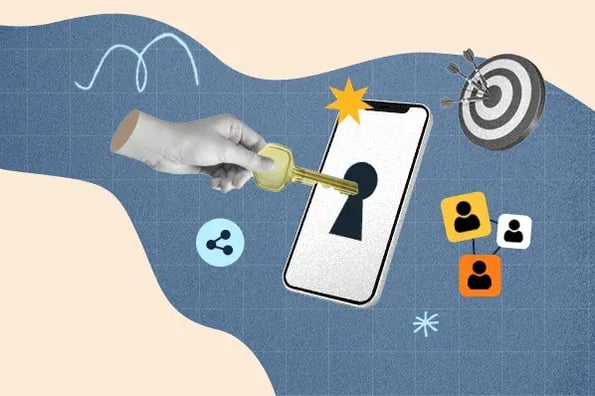Learn how to build professional relationships that don’t just open doors — but blow them wide open.


Building strong professional relationships is your secret weapon for marketing success. The right connections can open you up to new ideas, reveal valuable opportunities, and give you the insights you need to solve tough problems.
As Kieran and I discuss in a recent episode of Marketing Against the Grain, however, building impactful relationships takes more than just attending networking events and exchanging business cards.
So how do you find the people who can truly elevate your game? And how do you actively add value to grow those relationships?
In this post, we dig into four strategies for improving your professional relationships. Fair warning: these aren’t your typical networking tips.
We’re talking about going deep, leading with value, and mastering the art of communication — tailored for industry leaders looking to make a real impact.
Strategies for Improving Your Professional Relationships
1. Seek out 10x conversations.
Kieran and I talk to a lot of people. It’s how we solve problems and learn. But here’s the thing: not all conversations are equal. You’ve got to seek out what we call “10x conversations.”
These conversations are the ones that shift your perspective and thinking entirely, leaving you with insights that alter the way you go about your work — and even your personal life.
When you find someone like that, don’t just have one conversation and move on. Dive in deep. Have ten more conversations with that person rather than spreading yourself thin with ten different people. The value is in the depth, not the breadth.
If you’re not sure how to find these people, here’s what I do: find a person you think is awesome at what they do — and then find out who they look up to. It’s a bit counterintuitive, but trust me, it works.
The people that everyone else in the industry thinks are the best? Figure out how to spend some time with them.
Then, go a step further — seek out the five people those experts think are even better. That’s where you’ll find the real 10x conversations.
“If you can find these people,” says Kieran, “They’re going to be absolute game-changers to your ability to learn.”
2. Rethink your networking approach.
When it comes to networking, Kieran and I both agree that it’s not about how many people you meet but how well you get to know the right ones — and that generally doesn’t happen at big, crowded networking events. Instead, real value comes from smaller, more focused 1:1 settings.
For example, I recently played golf with my friend, Dave Gerhardt. We spent about four hours together, just the two of us, and by the end of it, we’d not only come up with a YouTube show idea, but we’d also tackled a bunch of other challenges that we were both facing.
That kind of focused time lets you dig deeper into topics and really get to know the person. It’s way more valuable than trying to meet dozens of people at once.
So next time you’re thinking about how to connect with someone or expand your network, think less about quantity and more about quality. Set up some one-on-one time — a dinner, a coffee, a golf game — and you’ll see the difference it makes.
3. Add value to build trust.
The more value that you bring to a relationship, the stronger the relationship becomes. It’s that simple. But you need to clearly — and consistently — demonstrate that value with every interaction.
For example, when Kieran first started out, he made it a point to jump on every call where he thought he could offer value. “I wasn’t just looking to take; I truly wanted to give where I could,” he says. “I’d join for 30 minutes, listen, and figure out how I could help.”
It wasn’t the most efficient way to build relationships, but over time, it led to deeper, more meaningful connections.
Why? Because building relationships isn’t just about being present; it’s about being the person who others can rely on for insight, support, or whatever they might need.
And when you consistently show up with something valuable to offer, you’re not just another contact in someone’s network — you’re the person they think of first when they need help or advice.
And that’s a key ingredient for building professional relationships that last.
4. Brush up on your qualitative communication skills.
Especially when you’re interacting with high-level execs like investors or founders, it’s not enough to just throw data at them — you need to tell the story behind the numbers.
Sure, executives love their charts and metrics, but they’re often more swayed by anecdotes and real-world examples. That’s where you win their buy-in, build trust, and gain the autonomy you need.
Think of it this way: as a marketing leader, you’ve got both the data and the stories at your disposal. The trick is to use them together. The data gives you credibility, but it’s the stories and anecdotes that make your argument stick.
Let’s say you’re pitching a new marketing strategy. Don’t just roll out the potential ROI. Back it up with a customer success story or some feedback that highlights why this strategy is the right move.
Executives are often swayed by what they hear from customers or industry peers, even more so than by what they see on a spreadsheet.
And remember, this tip isn’t only relevant for today. As Kieran points out, “Communicating qualitative data is a skill set that executives are going to have to hone more in the coming years, as we’re getting less and less direct attribution.”
To watch our entire discussion about improving your professional relationships, check out the full episode of Marketing Against the Grain below:
This blog series is in partnership with Marketing Against the Grain, the video podcast. It digs deeper into ideas shared by marketing leaders Kipp Bodnar (HubSpot’s CMO) and Kieran Flanagan (SVP, Marketing at HubSpot) as they unpack growth strategies and learn from standout founders and peers.














Comment here